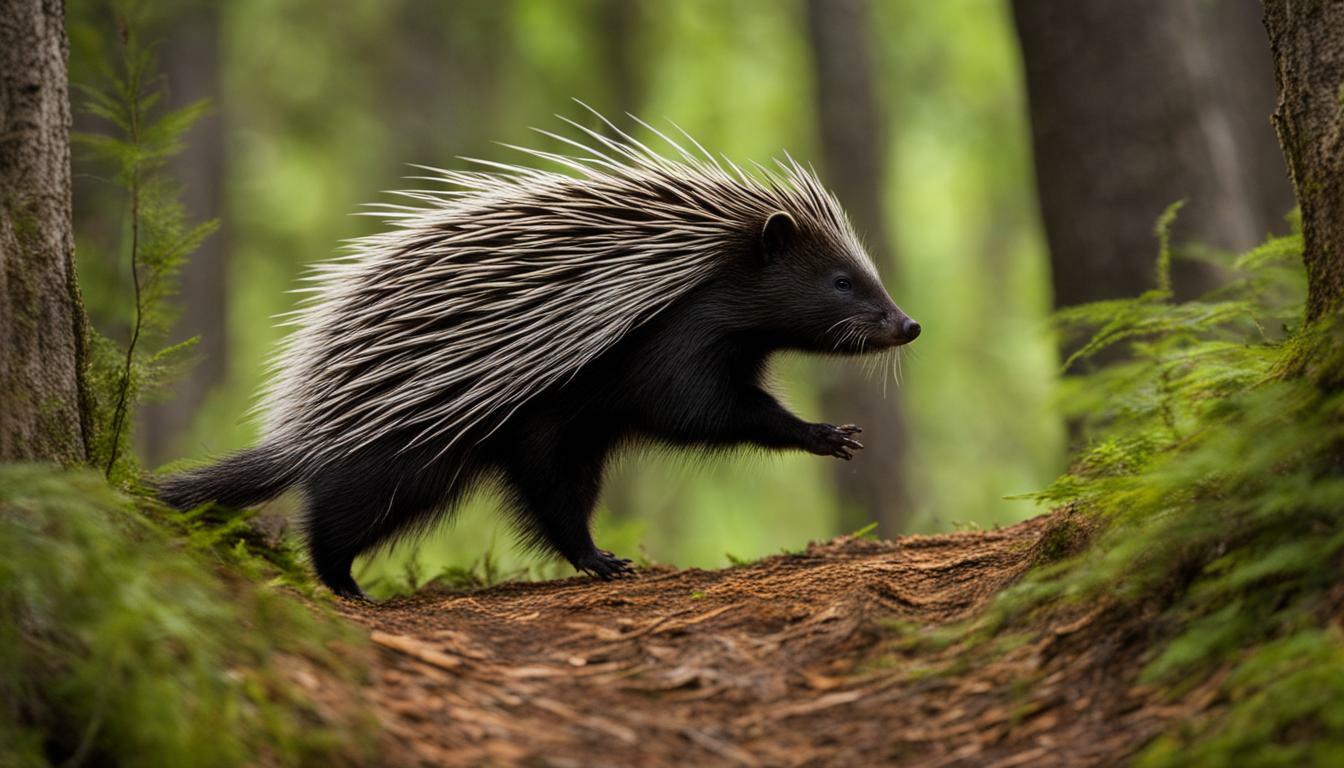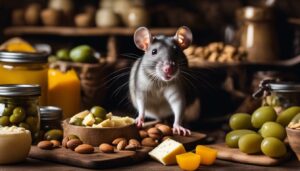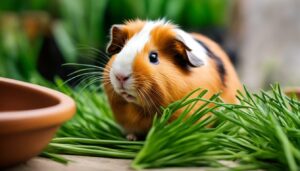Porcupines may not be known for their speed, but they can reach a top speed of about 6 miles per hour. While they are more inclined to walk or remain in place, porcupines have the ability to run if they feel threatened. However, their running capabilities are not their primary defense mechanism.
Porcupines have sharp quills on their backs, which act as a means of protection. These quills easily get stuck in a predator’s skin, making it difficult for them to pursue or attack the porcupine. As a result, porcupines rely on their quills rather than their running speed to deter threats.
Typically, porcupines live in pairs or small groups and may resort to running away or attacking if approached too closely. Their average weight ranges from 18 to 35 pounds, with an average length of 25 to 35 inches. Porcupines have a lifespan of 8 to 15 years, during which they have adapted to survive in their environment through various means of defense.
Key Takeaways:
- Porcupines can reach a top speed of about 6 miles per hour.
- Quills on their backs act as their primary defense mechanism.
- Porcupines typically live in pairs or small groups.
- They may run away or attack if approached too closely.
- Porcupines have an average weight of 18 to 35 pounds and a length of 25 to 35 inches.
Porcupine Locomotion
Porcupines are more inclined to walk or remain stationary, but they can run if they feel threatened. While they are not known for their speed, porcupines can reach a top speed of about 6 miles per hour when necessary. Their primary mode of locomotion is walking, which they do at a leisurely pace. However, if a porcupine perceives danger, it will break into a sprint to escape potential threats.
Porcupines’ running speed may not be impressive compared to other animals, but their unique defense mechanism compensates for their lack of speed. Porcupines have sharp quills on their backs, which serve as a deterrent to predators. When threatened, a porcupine will raise its quills, making it difficult for predators to attack without getting pierced by the sharp quills.
Porcupines typically live in pairs or small groups, and their running behavior is influenced by their social structure. When approached too closely, porcupines may choose to run away or attack if they feel their safety is compromised. Their ability to run, even if not particularly fast, is a key aspect of their survival strategy.
| Average Weight | Average Length | Lifespan |
|---|---|---|
| 18-35 pounds | 25-35 inches | 8-15 years |
Porcupine Defense Mechanisms
Porcupines rely on their agility and running capabilities to defend themselves from predators. Although they are not known for their speed, they can reach a top speed of about 6 miles per hour when necessary. However, their primary defense mechanism is their quills.
The sharp quills covering their backs serve as a formidable deterrent to predators. When threatened, porcupines will raise their quills and may even stamp their feet in warning. If the predator persists, the porcupine will run away, using its agility to outmaneuver potential threats.
In addition to their quills and running abilities, porcupines are also adept climbers. They can quickly scurry up trees to escape danger, using their sharp claws to grip the bark. This skill allows them to reach higher ground where predators, such as wolves or cougars, cannot follow.
| Porcupine Defense Mechanisms | Summary |
|---|---|
| Agility | Porcupines rely on their agility to evade predators and escape danger. |
| Running capabilities | While not fast runners, porcupines can reach speeds of up to 6 miles per hour when needed. |
| Quills | The sharp quills covering a porcupine’s back serve as a deterrent to predators, easily sticking into their skin upon contact. |
| Climbing | Porcupines are skilled climbers, using their sharp claws to scale trees and escape predators that cannot follow them. |
Despite their limited speed, porcupines have evolved effective defense mechanisms to ensure their survival. Their agility, running capabilities, quills, and climbing skills all work together to protect them from potential threats in their environment.
Porcupine Quills
Porcupines have sharp quills on their backs that can easily get stuck in a predator’s skin. These quills serve as a powerful defense mechanism, deterring potential threats and predators. When a porcupine feels threatened, it will raise its quills, making itself appear larger and more formidable. The quills are barbed, making them difficult to remove once they have penetrated the predator’s skin. This can cause pain, discomfort, and even infection for the predator, discouraging them from further aggression.
The quills of a porcupine are an essential part of its anatomy. They are modified hairs that have a hard, sharp tip and a hollow structure. This allows the quills to easily penetrate the skin of an attacker and become embedded. The base of the quill is filled with tiny muscles that contract, causing the quills to become firmly lodged in the predator’s flesh. As a result, any attempt to dislodge the quills can cause further injury and pain.
Porcupines have a fascinating ability to regrow their quills. If a quill becomes dislodged or broken, a new one will grow in its place. This continuous regeneration ensures that the porcupine always has a formidable defense mechanism at its disposal. The quills are not only used for defense but also serve as a warning to potential predators. The sight of a porcupine with its quills raised is enough to deter many predators from initiating an attack.
| Porcupine Quills: | Sharp and barbed |
|---|---|
| Structure: | Hollow with a hard, sharp tip |
| Defense Mechanism: | Deterring predators and causing pain, discomfort, and infection |
| Regeneration: | Porcupines can regrow their quills if they become dislodged or broken |
Social Behavior of Porcupines
Porcupines typically live in pairs or small groups, exhibiting interesting social behavior. They are not known for their speed but can run at a top speed of about 6 miles per hour if they feel threatened. While they are more inclined to walk or remain in place, porcupines will not hesitate to run away or attack if approached too closely.
Their tendency to live in pairs or small groups is likely a means of protection and support. By sticking together, they can increase their chances of survival against potential predators. This social behavior also allows them to communicate with each other through various vocalizations and scent markings, helping to establish boundaries and maintain group cohesion.
Porcupines are generally peaceful animals, but when threatened, they can exhibit aggressive behavior. They may raise their quills, making themselves appear larger and more intimidating to potential threats. If this display does not deter the predator, the porcupine may lunge or charge at them, using their quills as a formidable defensive weapon. The quills, which are sharp and barbed, can easily get stuck in an attacker’s skin, causing pain and discomfort.
Table: Comparison of Porcupine Social Behavior
| Pairs | Small Groups | |
|---|---|---|
| Size | Usually a male and female | Around 3-5 individuals |
| Communication | Vocalizations and scent markings | Vocalizations, scent markings, and physical contact |
| Behavior when approached | May run away or attack | May run away or attack |
Porcupines’ social behavior, along with their other adaptations such as sharp quills and defensive maneuvers, allows them to navigate their environment and protect themselves effectively. While they may not be fast runners, they have developed unique strategies to thrive and survive.
Physical Characteristics of Porcupines
Porcupines have an average weight of 18-35 pounds, an average length of 25-35 inches, and a lifespan of 8-15 years. Despite their size and weight, porcupines are not known for their speed. They are more inclined to walk or remain in place, but if they feel threatened, they can run at a top speed of about 6 miles per hour.
Porcupines’ running capabilities are not their primary means of defense. Instead, they rely on their unique quills for protection. These sharp quills, found on their backs, can easily get stuck in the skin of predators. When threatened, porcupines may run away or attack by turning their backs and swinging their quilled tails towards the attacker.
In addition to their running capabilities, porcupines possess other physical characteristics that contribute to their survival. They typically live in pairs or small groups, and their social behavior plays a role in their running behavior. When approached too closely, porcupines may choose to run away, displaying their agility despite their relatively slow speed.
Overall, porcupines are not fast runners, but they have adapted to survive in their environment through other means of defense, such as their quills and social behaviors. The table below summarizes the physical characteristics of porcupines:
| Physical Characteristics | Measurements |
|---|---|
| Weight | 18-35 pounds |
| Length | 25-35 inches |
| Lifespan | 8-15 years |
Adaptation to Survival
Porcupines have evolved to survive in their environment through their unique defense mechanisms and the use of their quills. While they may not be known for their speed, porcupines have developed other strategies to protect themselves from predators.
One of the most notable features of porcupines is their quills. These sharp, barbed spines serve as a highly effective defense mechanism. When threatened, porcupines can raise their quills, making them stand out and appear larger. If a predator gets too close, the porcupine will quickly turn its back, exposing the quills. The quills are designed to detach easily from the porcupine’s skin and lodge into the predator, causing pain, discomfort, and potential injury.
In addition to their quills, porcupines also rely on their ability to run or move quickly when needed. Although they are not fast runners, capable of reaching speeds of about 6 miles per hour, porcupines can use their agility to escape danger. They may run away from a threat or climb trees, utilizing their strong claws.
| Porcupine Characteristics | Average |
|---|---|
| Weight | 18-35 pounds |
| Length | 25-35 inches |
| Lifespan | 8-15 years |
While porcupines may not rely on their running capabilities as their primary defense mechanism, their ability to run when threatened, combined with their sharp quills, allows them to adapt and survive in their environment.
Behavioral Responses of Porcupines
When threatened, porcupines may exhibit running behavior or respond aggressively to protect themselves. Although not known for their speed, porcupines can run at a top speed of about 6 miles per hour. However, they are more inclined to walk or remain in place, relying on their natural defenses.
Porcupines have sharp quills on their backs, which serve as their primary means of defense. These quills can easily get stuck in a predator’s skin, causing pain and potential injury. When approached too closely, porcupines may run away or attack by violently thrashing their quilled tails and charging at the threat.
Typically, porcupines live in pairs or small groups, and their behavior can vary depending on the situation. Some porcupines may prefer to flee and seek shelter in trees or rocky areas when facing danger, while others may stand their ground and rely on their quills for protection. Their response to threats is instinctive, and they adapt their behavior accordingly.
| Statistics: | Measurements: |
|---|---|
| Average Weight | 18-35 pounds |
| Average Length | 25-35 inches |
| Lifespan | 8-15 years |
Porcupines may not be fast runners, but they have adapted to survive in their environment through the use of their quills and defensive behaviors. Their ability to run, albeit not their main mode of locomotion, plays a role in avoiding threats and ensuring their safety.
Conclusion
Porcupines may not be known for their speed, but they possess unique adaptations and defense mechanisms to survive in their environment. While they can run at a top speed of about 6 miles per hour, they are more inclined to walk or remain in place. However, if they feel threatened, porcupines are quick to use their running capabilities to escape potential danger.
These fascinating creatures rely heavily on their quills for defense. With sharp quills on their backs, porcupines can easily deter predators by embedding them in their attacker’s skin. This effective defense mechanism allows porcupines to confidently navigate their surroundings and escape potential threats.
In addition to their quills, porcupines also utilize their social behavior as a means of protection. Typically living in pairs or small groups, they have established a system of mutual support and vigilance. When approached too closely, porcupines may choose to either flee or attack, depending on the situation. This behavior ensures their safety and minimizes the risk of being caught by predators.
While porcupines may not be the fastest runners, they have adapted to survive in their environment through other means of defense. With an average weight of 18-35 pounds and an average length of 25-35 inches, they possess physical characteristics that aid in their survival. Additionally, their lifespan of 8-15 years allows them to make the most of their unique adaptations and continue thriving in their natural habitats.
FAQ
How fast can a porcupine run?
Porcupines can run at a top speed of about 6 miles per hour.
What is the locomotion of porcupines like?
Porcupines are more inclined to walk or remain in place, but they will run if they feel threatened.
What defense mechanisms do porcupines have?
Porcupines rely on their sharp quills for defense and can easily get stuck in a predator’s skin.
Do porcupines live in groups?
Yes, porcupines typically live in pairs or small groups.
What are the average weight, length, and lifespan of porcupines?
Porcupines have an average weight of 18-35 pounds, average length of 25-35 inches, and a lifespan of 8-15 years.
How have porcupines adapted to survive?
Porcupines have adapted to survive by relying on their quills and other defense mechanisms rather than speed.
How do porcupines behave when faced with threats?
Porcupines may run away or attack if approached too closely.




